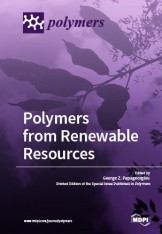abstract
Polyesters made from 2,5-furandicarboxylic acid (FDCA) have been in the spotlight due totheir renewable origins, together with the promising thermal, mechanical, and/or barrier properties.Following the same trend, (nano)composite materials based on FDCA could also generate similarinterest, especially because novel materials with enhanced or refined properties could be obtained.This paper presents a case study on the use of furanoate-based polyesters and bacterial cellulose toprepare nanocomposites, namely acetylated bacterial cellulose/poly(butylene 2,5-furandicarboxylate)and acetylated bacterial cellulose/poly(butylene 2,5-furandicarboxylate)-co-(butylene diglycolate)s.The balance between flexibility, prompted by the furanoate-diglycolate polymeric matrix; and the highstrength prompted by the bacterial cellulose fibres, enabled the preparation of a wide range of newnanocomposite materials. The new nanocomposites had a glass transition between−25–46◦C and amelting temperature of 61–174◦C; and they were thermally stable up to 239–324◦C. Furthermore,these materials were highly reinforced materials with an enhanced Young’s modulus (up to 1239 MPa)compared to their neat copolyester counterparts. This was associated with both the reinforcing actionof the cellulose fibres and the degree of crystallinity of the nanocomposites. In terms of elongation atbreak, the nanocomposites prepared from copolyesters with higher amounts of diglycolate moietiesdisplayed higher elongations due to the soft nature of these segments.
authors
Marina Matos, Andreia Sousa, Nuno H.C.S. silva, Carmen S.R. Freire, Márcia Andrade, Adélio Mnedes, Armando J.D. Silvestre




